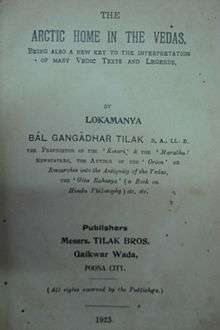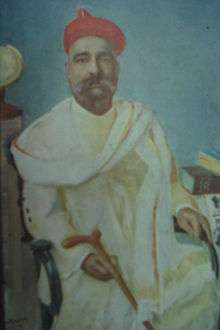The Arctic Home in the Vedas
The Arctic Home in the Vedas is a 1903 book on the origin of Aryanic People by Bal Gangadhar Tilak, a mathematician turned astronomer, historian, journalist, philosopher and political leader of India. It propounded the idea that the North Pole was the original home of Aryans during the pre-glacial period which they had to leave due to the ice deluge around 8000 B.C. and had to migrate to the Northern parts of Europe and Asia in search of lands for new settlements. In support to his theory, Tilak presented certain Vedic hymns, Avestic passages, Vedic chronology and Vedic calendars with interpretations of the contents in detail.
 The title page of the 1925 edition of The Arctic Home in the Vedas | |
| Author | Bal Gangadhar Tilak |
|---|---|
| Country | India |
| Language | English |
| Subject | History |
Publication date | 1903 |
| Media type | Print (hardback) |
| ISBN | 9781907166341 |
The book was written at the end of 1898, but was first published in March 1903 in Pune.
Background
Man was believed to be post-glacial, and the theory of an Asiatic origin of the Aryan peoples prevailed. The age of the oldest Vedic period, however, was carried back to 4500 BC by scholars including the author himself after scientific astronomical research in correlation with the evidence found in the Vedic hymns.
Tilak cites a book by William F. Warren, the first President of Boston University, Paradise Found or the Cradle of the Human Race at the North Pole, as having anticipated his ideas to some extent. Warren dedicated his book to Max Müller, with whom Tilak had shared ideas before the book was completed.
Tilak held the view that further study of Vedic hymns and Avestan passages might reveal the long vista of primitive Aryan antiquity.
Summary of Tilak’s polar theory
- Neolithic Aryan race in Europe cannot be regarded as autochthonous, nor European Aryans descended from the Paleolithic man. Hence, question of the original Aryan home is still unsettled.
- In the early geological ages, the Alps were low, the Himalayas not yet upheaved, Asia and Africa were represented only by a group of islands and an equable and uniform climate prevailed over the whole surface of the globe. In those days, however, a warm climate prevailed in the Arctic region.
- The close of the Pliocene and the whole of the Pleistocene period were marked by violent changes of climate bringing on what is called the Glacial and Inter-Glacial epochs. A succession of cold and warm climates must have characterized these Glacial and Inter-Glacial periods which were also accompanied by extensive movements of depression and elevation of land, the depression taking place after the land was weighed down with the enormous mass of ice.
- Thus a period of glaciations was marked by elevation, extreme cold and the invasion of the ice-caps over regions of the present Temperate zone; while an inter-glacial period was accompanied by depression of land and milder and congenial climate which made even the Arctic regions habitable.
- According to the latest geological evidence, the last Glacial period must have closed and Post-Glacial must have commenced at about 10,000 years ago or 8,000 BC. There were at least two Glacial and one Inter-Glacial period, and the geographical distribution of land and water on the earth during the Inter-Glacial period was quite different from what it is at present. It was the coming on of the Glacial age that destroyed this genial climate and rendered the regions unsuited for the habitation of tropical plants and animals.
- At the North Pole, one sees the heavenly dome above seems to revolve around one like a potter's wheel. The stars will not rise and set but move round and round in horizontal planes during the long night of six months. The Sun, when it is above the horizon for six months; would also appear to revolve in the same way but with some difference. The Northern celestial hemisphere will alone be visible spinning round and round and the Southern half remain invisible. The Sun going into the Northern hemisphere in his annual course will appear as coming up from the South. Living in the temperate and tropical zones, however, one sees all heavenly objects rise in the East and set in the West, some passing over the head, others traveling obliquely.
- The long dawn of two months is a special and important characteristic of the North Pole. As we descend southward, the splendor and the duration of the dawn will be witnessed on a less and less magnificent scale. But the dawn occurring at the end of the long night of two, three or more months will still be unusually long, often of several days duration.
- All these characteristics of an Arctic home are clearly recorded in several Vedic hymns and Avestic passages and they come to us sometimes as the description of the prevailing conditions or the day-to-day experience or stories told by the earlier generation and sometimes as myths.
Chronology of the post-glacial period

- 10,000 to 8000 BC – The destruction of the original Arctic home by the last Ice Age and the commencement of the post-Glacial period.
- 8000 to 5000 BC – The age of migration from the original home. The survivors of the Aryan race roamed over the northern parts of Europe and Asia in search of lands suitable for new settlements. Tilak calls it the Pre-Orion Period.
- 5000 to 3000 BC. – The Orion period, when the vernal equinox was in Orion. Many Vedic hymns can be traced to the early part of this period and the bards of the race seem to have not yet forgotten the real importance of the traditions of the Arctic home inherited by them. It was at this time that first attempts to reform the calendar and the sacrificial system appear to have been systematically made.
- 3000 to 1400 BC – The Krittika period, when the vernal equinox was in Pleiades. The traditions about the original Arctic home had grown dim by this time and were often misunderstood, making the Vedic hymns less and less intelligible.
- 1400 to 500 BC – The Pre-Buddhistic period, when the Sutras and the Philosophical systems made their appearance.
Contents
The book has about 470 pages, containing a Preface by the Author and thirteen chapters.
Scriptural sources in support of the theory
1) Vedic References
- Particulars of Hymns and Verses in ten Mandalas of Rigveda are given. For example, Hymn 1, Verse 2, Page 459.
- Particulars of Passages in Taittiriya Samhita are given. For example, Passage I, 3, 9, 2, Page 91.
- Particulars of Hymns in Vajasaneyi Samhita are given.
- Particulars of Sama Veda Samhita are given.
- Particulars of Atharva Veda Samhita are given.
- Particulars of Aitareya Brahmana are given.
- Particulars of Kaushitaki Brahmana are given.
- Particulars of Taittiriya Brahmana are given.
- Particulars of Shatapatha Brahmana are given.
- Particulars of Tandya Brahmana are given.
- Particulars of Sadvimsha Brahmana are given.
- Particulars of Taittiriya Aranyaka are given.
- Particulars of Upanishads are given.
2) Avestic References
Influence
The Arctic Home in the Vedas has been cited in the works of Julius Evola, Savitri Devi, Rene Guenon, Jean Haudry and John G. Bennett. M.S. Golwalkar, in his 1939 publication We or Our Nationhood Defined, famously stated that "Undoubtedly [...] we — Hindus — have been in undisputed and undisturbed possession of this land for over eight or even ten thousand years before the land was invaded by any foreign race."[1] Golwalkar was inspired by Tilak's[note 1] The Arctic Home in the Vedas.[2] Gowalkar took over the idea of 10,000 years, arguing that the North Pole at that time was located in India.[2][note 2]
See also
Notes
- Carol Schaeffer: "Tilak, dubbed the “father of Indian unrest” for his advocacy of violent tactics against British colonialists and inspiration to later Indian Hindu nationalists".[2]
- See also Is our civilisation really 10 millennia old? Or are we simply insecure?; Sanjeev Sabhlok (2013), Not to be outdone by Müller, Tilak proposed that Aryans descended from the north pole. and Golwalkar’s most fantastic and absurd attempt to “prove” that the non-existent Aryans were from India.
References
- The Arctic Home in the Vedas by B.G. Tilak, edition 1925.
- Gyanendra Pandey (2006), Routine Violence: Nations, Fragments, Histories, Stanford University Press, p.103
- Carol Schaeffer (2018), Alt-Reich. The unholy alliance between India and the new global wave of white supremacy, The Caravan (2018), p.42